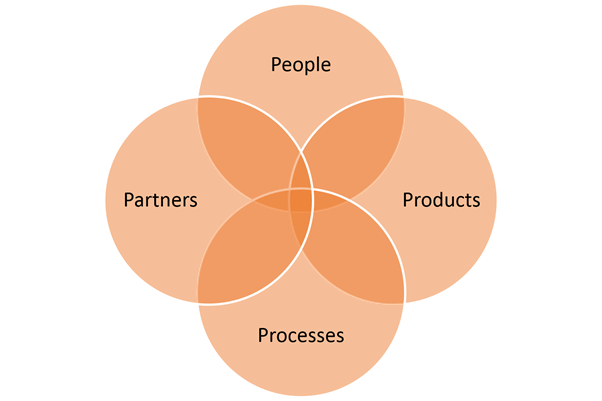To ensure that the IT services provided by a company are suitable for its purpose and use, it is imperative that we consider the 4 p's.
The purpose of the Service Strategy Based on ITIL, is to serve as a guide when establishing and prioritizing objectives and opportunities, for this, we must know the market and the services of the competition to adjust our services to the requirements of the Client of the services.
Failure to take into account the 4 P's could lead to services that do not adequately meet the needs of businesses, in the IT department and users.
To get the most benefit from the use of the 4 Ps, organizations must determine the roles of processes and people; then implement the tools to automate processes, facilitating the functions and tasks of people.
But who participates in the 4 p's?
People are fundamental to the development, deployment and operation of any IT service. A good relationship between a service provider and its customers depends on the customer receiving an affordable service that meets their needs and performs at an acceptable level. Without understanding the results of the clients or the value they want to obtain from the service, there is a great opportunity that the designed service does not meet their needs, resulting in wasted resources and opportunities for the organization involved. IT personnel involved in the design and provision of the service must be properly trained and equipped to ensure that customer requirements are met.
The Processes include all the roles, responsibilities, tools and administration controls required to reliably deliver the results. A mature process is one in which adequate controls and enablers have been provided to allow process activities to function effectively and efficiently. Regardless of whether they are automated or manual, it is vital to develop appropriate processes to support the new services and ensure that once the services are operational, the correct activities and roles of the process, inventory or billing are implemented.
Products refer to the service itself. The balance between functionality, performance and cost, the choice of the right technology cannot be overstated. While the main driver will be the characteristics that come from the customers' requirements, it has to be backed by the right environment, infrastructure, applications, interfaces and data sources that will make the service work.
Partners have become essential elements for the provision of IT services today, particularly in this era of outsourcing, managed services and Cloud Computing. Any service provider will generally acquire the service components of an approved provider, and the support contract will usually specify terms, conditions and objectives that will support the service levels agreed with the customer. Whether it is a strategic, tactical, operational or commodity supplier, it is essential that a good working relationship be established, since the IT service provider will never meet the business needs without the help of a partner in tune with the needs of the organization.
The design of any IT service must consider all the elements necessary for the service to be delivered and managed in the manner that the client anticipates and will result in value for the cost.

